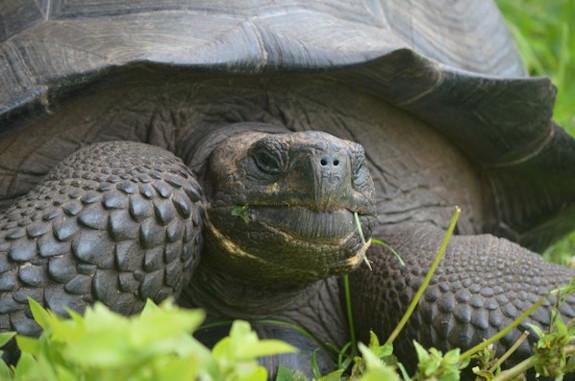
The newfound Galapagos tortoise species (Chelonoidis donfaustoi), also known as the Eastern Santa Cruz Tortoise. © Washington Tapia.
Recent genetic tests performed on two groups of about giant tortoises living on the island of Santa Cruz has revealed the existence of a brand new species. Previously, scientists believed that tortoises living on the western and eastern sides of Santa Cruz belonged to the same species. Since they look slightly different, scientists decided to run genetic tests just to be sure.
The results were beyond surprising: not only are the two populations of tortoises different species, they are not even very closely related. In fact, the species are as distinct from one another as they are from tortoise species living on different islands, even though they only live about six miles apart.
Chelonoidis porter was the name given to the species of tortoise on Santa Cruz. Now it’s clear that the species is restricted to the western side of the island. The newly identified eastern species has been named Chelonoidis donfaustoi, in honor of Fausto Llerena Sánchez, a Galápagos National Park ranger who spent 43 years caring for endangered tortoises in captivity.
According to the results of the study, published online on October 31 in the journal Plos One, the two species evolved hundreds of thousands of years apart. Chelonoidis porter evolved about 1.74 million years ago and is one of the oldest tortoise lineages in the archipelago. Chelonoidis donfaustoi evolved about a half a million years ago and appears to be more closely related to tortoises found on other Galapagos Islands than they are to their distant cousins on the western side of Santa Cruz.
The new findings may have serious implications for tortoise conservation going forward, Adalgisa Caccone, a senior ecology and evolutionary biology research scientist at Yale University, told Live Science. The western Santa Cruz tortoise population is doing quite well, with about 2,000 individuals, while the eastern species only has about 250 members. Now that it’s clear that the eastern group represents a distinct species, it may receive additional protections.
When Charles Darwin arrived in the Galapagos Islands there were believed to be 15 distinct species of giant tortoise living there. Four of those species are now extinct thanks to predation by humans, invasive species, and habitat destruction. The discovery of an entirely new giant tortoise species is truly momentous.































